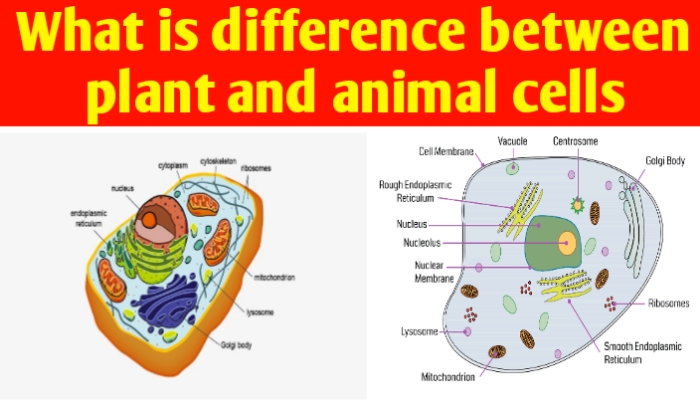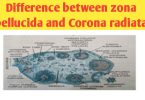What is difference between animal and plant cell l definition and examples of animal cell l definition and examples of plant cell
You all know about the all organisms are composed of cells, which is the basic structural and functional unit in all living organisms, according to the availability of cell walls, plastids, centrioles and large central vacuole, the cell categories into two types- plant cells and animal cells.

What is difference between animal and plant cell
How does a plant cell differ from an animal cell? when you compare between animal cells and plant cells, plant cells possess cell walls, plastids and large central vacuole on other hand it is absent from animal cell, animal cell have centriole that is absent from plant cell.
Hi guys in this articles we know about definition of animal cell and plant cell with examples and compare/ differences/ contrast/ distinguish between plant and animal cells, this question is very important for class 8th, 9th, 10th, 11th and 12th students, those prepare for competitive and annual board examinations.
You can also click on the given link to see others topic in our website and YouTube channels
◆ ALSO READ: HEART ANATOMY, PHYSIOLOGY, LOCATION, DISEASE & TREATMENT
Definition of animal cells
Definition of animal cells:- An animal cells is type of eukaryotic cell which possess true nucleus and specialized structures called organelles, that carry out different functions and it has centriole carries out formation of spindles and centrosomes which helps in cell division of cells.
An animal cell lack of a rigid cell so animals allow to develop a greater diversity of cell types, and tissues, examples of common animal cells includes fat cells, muscle cells, stem cells etc.
Definition of plant cells
Definition of plant cells:- The plant cells is defined as the type of eukaryotic cell which possess cell walls containing cellulose, hemicellulose and pectin, plastids, chlorophyll pigment, thylakoids, having unique features of photosynthesis and storch starch, large central vacuole that regulate turgor pressure.
Example of plant cells are merismetic cells, parenchyma cells, collenchyma cells, sclerenchyma etc.
What is difference between animal and plant cells
This question is very important for class 8th,9th,10th and 12th students and those preparing for competitive and annual board examinations.
Regarding this,“what is difference between animal cells and plant cells,” as you know all eukaryotic cells are not identical, animal cells and plants cells are different as the animal cells do not possess cell walls, plastids, and a large central vacuole but having centrioles, contractile vacuoles and enclosed a thin flexible living membrane only while plant cells possess cell walls in addition to plasma membrane, plastids and a large central vacuoles are also found.
Comparison/ difference between animal and plant cells are as follows:-
Animal cells:-
1. Animal is enclosed by a thin flexible living plasma membrane only.
2. It has many small temporary vacuoles, its nucleus is generally near the centre.
3. Centrosome is present practically in all animal cells, plastids are absent so there is no chlorophyll pigment in it.
4. Numerous mitochondria are present there and cristae of mitochondria are plate-like structure.
5. Intermediate fibres are often present forming a part of cytoskeleton, crystals are not present there, contractile vacuole is available in it, plays important role to pump out excess water.
6. Animal cell may change form and move about .tissue fluid containing sodium chloride bathes the animal cells.
7. Animal cell cannot synthesise all amino acids, coenzymes and vitamins.
8. Animal cells are much smaller than hundred micrometre, glyoxysomes are lacking in the animal cells.
9. Spindle formed during cell division is amphiastral, has an aster at each pole, cytoplasm always devides by furrowing.
10. If animals cell placed in a hypotonic solution it swell up and burst due to lack of cell wall.
11. It stores carbohydrate as glycogen.
12.. Golgi apparatus occurs as a single or a few scattered units called dictyosomes.
13. Tight junctions are desmosomes are present between cells, rough endoplasmic reticulum is abundant.
14. Cyclic nucleotides are present, golgi complex consists of more cisternae, all animal cells contain lysosomes.
15. Only zygote and stem cells of early embryos are totipotent,having capacity of a living nucleated cell to differentiate into any type of cell.
Plants cells:-
1. Plant cell is enclosed by a thick, rigid, dead cell wall in addition to plasma membrane.
2. It has a large permanent sap vacuole, its nucleus is pushed to one side in the peripheral cytoplasm by the sap vacuole.
3. Centrosomes occurs only in mitotic cells of lower plants, plastids are usually present, containing chlorophyll in it.
4. Mitochondria are fewer and cristae of mitochondria are tubular.
5. Intermediate fibres are lacking, crystals are present, there is no contractile vacuole in it.
6. Firm cell wall prevents undue enlargement, change in form and position of plant cells.
7. Plant cell can synthesise all the amino acids, coenzymes and vitamins.
8. Plants size are well over 100 micrometre,
glyoxysomes are present.
9. Cytoplasm divides by cell plate method and spindle formed during cell division is anastral without asters at the poles.
10. If plant cell placed in a hypotonic solution, plant cells do not swell up or burst due to presence of cell wall.
11. Plant cell stores carbohydrate as starch.
12. Golgi apparatus are found as numerous scattered units called the dictysomes.
13. Tight junction and desmosomes are lacking,rough endoplasmic reticulum is sparse, chromosome are relatively large.
14. Cyclic nucleotides are lacking, Golgi complex comprises fewer cisternae, lysosomes are less prevalent in plant cells.
15. All plant cells are totipotent that is capacity of a living nucleated cell to differentiate into any type of cell.







Leave a Comment